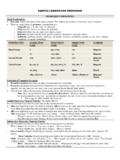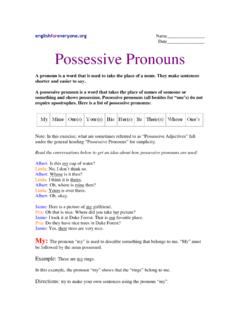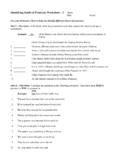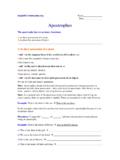Transcription of Possessive Apostrophes 1 On Your Marks!
1 1 Grammar and Spelling BugPossessive Apostrophes1 On your Marks! ObjectiveTo indicate possession by using the Possessive apostrophe with singular and plural nounsKey defi nitionA Possessive apostrophe is an apostrophe used to show ownership of something or things by Get Ready Prior knowledgeChildren should have a solid understanding of the following. Singular forms of nouns Plural forms of nouns Apostrophes used to create contractions Recap previous grammar, punctuation and spelling knowledge acquired and touch on areas of uncertainty highlighted in the Diagnostic Check, particularly regarding plural forms of nouns and Apostrophes for that this session will develop children s understanding of how to identify and use Possessive Apostrophes , to enable them to begin to use them confi dently within are words that represent a person, place, object or idea, girl , home , bicycle or happiness.
2 A singular noun represents one person, place, object or idea, girl or bicycle .A plural noun represents more than one person, place, object or idea, girls or bicycles . 104/09/2013 16:452 Grammar and Spelling BugA contraction is a shortened form of a word, which can use an apostrophe to make it shorter. For example, could not becomes couldn t and cannot becomes can t .Purpose and applicationA Possessive apostrophe is used to indicate possession of something or things by a noun is in its singular form, an apostrophe and the letter s are added to show possession ( the girl s shoes ).This includes instances in which a person s name or a place (a proper noun) ends in an s in the singular form ( James s grey hat and Paris s many shops ). It also includes instances in which a plural word is being used to denote a singular person, place, object or idea, for example in a business name ( I really love Ian s Incredible Ice-Creams s variety ) although this construction can usually be avoided ( I really love the variety of Ian s Incredible Ice-Creams ).
3 When a noun is in its plural form, only an apostrophe is added after the letter s of the plural ( the girls shoes ).When an irregular plural (one not ending with an s ) needs a Possessive apostrophe, an apostrophe and the letter s are added, just as in the singular form ( children s and sheep s ).When you use Possessive pronouns to indicate to what or whom something belongs, you do not need an apostrophe. For example, his , hers , its , ours , yours , theirs and whose .The most common error children make when they fi rst learn about the Possessive apostrophe is that they begin to use it in any word that ends in an s , whether or not the word is Possessive . For example, The hen s laid their eggs in the hen house. The hen s laid its eggs in the hen house is a correct example of a contraction apostrophe, as hen s could here mean hen has .It is important for children to see the Possessive apostrophe being used in a range of texts so that they fully understand how it is used 204/09/2013 16:453 Grammar and Spelling Bug3 Get SetResources The Possessive Apostrophes diagnostic check PDF This Possessive Apostrophes teaching sequence The Possessive Apostrophes video The Possessive Apostrophes game sequence (see below) The Possessive Apostrophes assessment PDF Strips of paper A hat or pot A bag of small objects belonging to the children (pencils, rubbers, toys etc.)
4 Cards or mini whiteboards and whiteboard pensActivities1. Write a number of singular nouns and simple singular noun phrases on a theme ( that car and wheel ) and put them into a hat or pot. Children choose a word or phrase and put it into its plural form. Challenge the children to put the plural form into a sentence. Children choose another word or phrase and must construct a phrase by changing their fi rst, now plural, selection to be Possessive of their second ( those cars wheels ) and put the phrase into a new Provide each table in the class with a selection of strips of paper featuring phrases that use the structure: The [object] belonging to [a child s name or a group of people] . Make sure there are some plural owners ( the pupils , some children , those teachers ). Ask the children to rewrite the sentences on the backs of the strips using the correct Possessive apostrophe.
5 For example, the chocolate bar belonging to Harry would become Harry s chocolate bar . Challenge the children to think of their own phrases for the rest of the Write similar phrases on cards or mini whiteboards, with the words The [object] , belonging to and [a child s name or group of people] on three different cards or mini whiteboards held by children. Have the class re-order the phrase to make one using a Possessive apostrophe. Have the child who was holding belonging to hold a whiteboard showing the additional s instead, and use a physical action to show the apostrophe. Repeat with multiple 304/09/2013 16:454 Grammar and Spelling Bug4. As a weekend or holiday challenge, ask children to hunt for and record Possessive Apostrophes , particularly in environmental print. Also give rewards for correctly capturing incorrect or missing Possessive Create signs for the classroom and school that use the Possessive apostrophe correctly.
6 For example, Year 3 s scissors , the teacher s desk , the teachers staffroom and the caretaker s offi ce .Practising with the BugPossessive Apostrophes Game 1 Pluralise words in sentence context, and spell irregular plurals not ending in s . Possessive Apostrophes Game 2 Match belonging to phrases with singular and plural Possessive Apostrophes Game 3 Compose sentences expressing ownership by substituting belonging to phrases for singular and plural Possessive Apostrophes Game 4 Spell regular and irregular Possessive plurals in sentence Apostrophes Game 5 Insert singular and plural Possessive Apostrophes into a Apostrophes Game 6 Compose sentences involving both singular and plural use of the Possessive Go!Noticing Possessive apostrophesEncourage children to fi nd Possessive Apostrophes within independent reading and writing. Use peer assessment for children to identify and assess use of Apostrophes in each other s work.
7 Rewards could be given for correct identifi cation of an apostrophe used accurately and correctly. Possessive 404/09/2013 16:455 Grammar and Spelling BugShared readingDuring any shared reading of text, particularly across the curriculum and in guided reading, ask the children to fi nd any use of the Possessive apostrophe and to highlight it to others. If doing shared reading with the whole class, cover up any words that might have a Possessive apostrophe and ask children to predict what they should say and why. Shared writingDuring a piece of shared or guided writing with the class, encourage children to add in the relevant Possessive apostrophe to the sentence or word. Make deliberate mistakes for the children to correct and give rewards to those children who notice them. Model how to use the Apostrophes correctly when composing a sentence and ask the children to help you if you get stuck.
8 Independent reading and writingPossessive Apostrophes should be used in all forms of writing, but may be particularly common in reports and biography. Set children the target or challenge of using them in all pieces or writing in subjects across the curriculum, and have them highlight their usage to encourage self- and 504/09/2013 16:45













